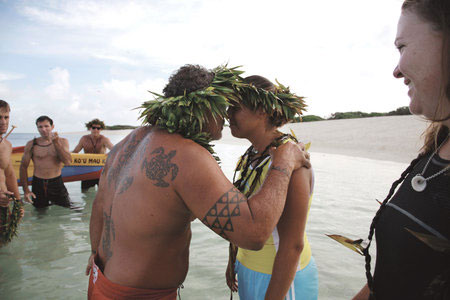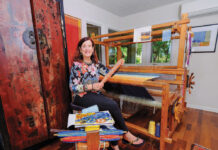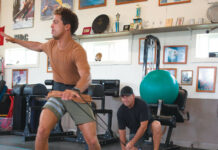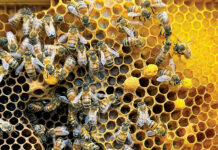Just Plein Fun
When West Maui artist Ronaldo Macedo envisioned last year’s inaugural Maui Plein Air Invitational, he knew he was onto something extraordinary. Not even Macedo, however, could have predicted the level of success the outdoor painting festival would enjoy. With the 2007 installment on deck for February 17 through 25, the Brazilian-born painter practically glows when reflecting on his pet project.
“It was a fun group of artists,” he says. “Their minds are always going, and ideas are always flowing.”
With the help of the Islanders, a group of Hawai‘i plein-air (outdoor) painters, Macedo has once again lined up a field of 25 artists for this year’s Invitational. Painting events include the opening-day Kick-Off Paint Out, Wednesday’s Sunset Paint Out, and Friday’s Lahaina Quick-Draw (which Lana‘i painter Mike Carroll describes as “a tight rope without a net”). See Calendar for details.
“It’s fun to see how different artists interpret the same location,” says Carroll, who sees the festival as a chance for the public to “look over the artists’ shoulders and see the whole process.”
Plein-air painting requires quick work to capture ever-changing light and shadow. “The artists have to make snap decisions and hope they can pull it off,” continues Carroll. As a result, the compositions appear “painterly,” rather than “overly rendered,” he says.
Carroll strongly encourages the public to attend the Friday night Opening Gala Reception—last year’s was the best exhibition he’s seen in Hawai‘i—where the week’s creations go on sale. “Anyone in West Maui has to see it, he says. “You may even see some of the paintings you saw being worked on during the week.” Paintings will remain on sale through the weekend.
“It’s not a competitive affair; it’s more like a collegial one,” says Carroll. Last year’s installment was his first invitational festival, and he welcomed the chance to get to know these top-tier artists’ personalities and techniques: “I was like a kid in a candy shop.”
Village Galleries, the Ritz-Carlton, Kapalua, and the West Maui Cultural Council will sponsor the festival.
—Jason Hilford
Men Are Easy
Men essentially need three things: food, sex, and appreciation, says Makawao author Lynn Rasmussen. “He’ll fix his own food if he gets the other two, and he can even go for a while without appreciation,” she says.
Yes, men are that easy, according to Rasmussen’s book, due out in March, aptly titled Men Are Easy. Rasmussen shakes off the idea that we should have to “work” on our relationships, saying that 99 percent of the time, when women take care of themselves first, perceived relationship issues will disappear.
“When you’re in a low mood, all you want to do is communicate,” Rasmussen says. “But the real problem is not your man; it’s that you haven’t eaten, or you’re tired, or you’re hormonal. That is not the time to communicate. That’s when you should drop it and go take care of yourself—go for a run, go to the movies, get a good night’s sleep.”
A life coach married for 30-plus years to the same man, and the mother of two grown children, Rasmussen could be a case study in how to live the “well-designed” life that her book, based on 20 years of research, extols. But she says she drew more on science than on personal experience to write the book. A board member of the International Society for Systems Science, she participates in weekly teleconferences researching the application of systems theory to the self.
Rasmussen is eager to share with women across the nation her simple theory: “Love is the opposite of work. Love is about enjoying yourself and others.” Yes, it’s that easy.
For more information, visit www.MenAreEasy.com.
—Sky Barnhart

What’s in a Word?
Pale strangers stumble ashore from the great sailing ship that has just appeared along a Hawaiian coastline in the late 1700s. Polite Hawaiians attempt to greet them in the local style, but these newcomers reject the traditional practice of touching noses. The Hawaiians conclude that these strangers are “without breath,” or spirit—in other words, ha (breath) ole (without). Put the words together, and we have the common word for Caucasians. Right? Wrong.
In fact, the word ha‘ole is an ancient one, far predating Western contact, meaning “foreigner.” It is found in the Kumulipo, a creation and genealogical chant that was recited for Captain James Cook during his visit to Hawai‘i Island in 1778.
Isolated though they were by that time, the Hawaiians’ cultural traditions recalled the days when strangers arrived from other islands to the south. Now they would have to deal with a new kind of ha‘ole, one who brought an alien world and all its changes to this ancient island civilization.
Today, the word ha‘ole has fallen into disrepute, exemplified by the erroneous story that claims newcomers lacked the all-important breath of life. But it is really a neutral word, simply describing someone or something from another place. Any value judgments it implies reside in the attitude and adjectives supplied by the user of this honorable old word.
—Jill Engledow
Midnight at the Oasis: Save the Date!
Ladies, haul out your harem clothes! Gentlemen, don something sheikh! Art Affair returns this spring with the theme of “Midnight at the Oasis.”
The biggest fund-raising event Hui No‘eau Visual Arts Center hosts each year, Art Affair benefits art programs for youngsters and grownups alike. It’s also one hell of a party.
Tickets at press time were expected to be around $150.
You say you just invested in obedience lessons for your camel, and the gala doesn’t fit your budget? For a mere $25, you can meet the artists, view their work, and enjoy pupu, as well as music by the VooDoo Suns, at the Hui’s Artists’ Party on Saturday, February 17, starting at 6 p.m. This week-ahead party is the Hui’s thank-you to all those donating artists. It’s become so much fun in its own right, you won’t want to miss it, nomad-er whether you plan to attend the Art Affair gala or not.
You can even bid on silent-auction items at the Artists’ Party, some of them available for purchase that night, others whose bidding will continue through a week of exhibition to the evening of Art Affair. (If, unlike Scheherezade, you hate a cliffhanger ending, you can always bid so generously, your auction rivals slink off into the desert sands.)
Tickets for the February 17 Artists’ Party will be available at the door. For tickets and information on the February 24 Art Affair, call Hui No‘eau at 572-6560.
—Rita Goldman
Grammy’s Slackers
In sequel to Masters of Hawaiian Slack Key Guitar—Volume 1, last year’s Grammy Award winner for Best Hawaiian Music Album of the Year, the gang of old-time ki ho‘alu strummers has generated a second release, a compilation of live mele (songs) from the Ritz-Carlton, Kapalua’s weekly concert series. If you can’t make it in person, throw in the new album titled Legends of Hawaiian Slack Key Guitar—Live from Maui, sit back, and find yourself transported to the venue.
Cofounders Paul Konwiser and Wayne Wong collaborated with weekly master of ceremonies George Kahumoku, Jr., to produce the album. All contributing artists foster the sheer delight so identified with Hawaiian music. And it’s already on the Grammy ballot.
Upbeat Hawaiian classics mingle with soft, romantic island ballads, capturing that, well, “certain something” that inevitably results from spontaneous music making. Personal stories and commentary give added weight to the songs’ meaning and locale, with applause left in for good measure.
Highlights include opener “Opihi Moemoe” (“Sleeping Limpet”), wherein Ledward Ka‘apana’s fingers flit about the strings like a Kamehameha butterfly. Cyril Pahinui adds a soulful rendition of “Ka Makani Ka ‘Ili Aloha,” about a man who uses a love potion to retrieve his wayward wife. And Dennis Kamakahi bends his strings to lyrical twangs while singing “Ahulili,” a mountain peak in Kaupo.
Visit www.slackkey.com to purchase the CD and see concert details.
—Ashley Stepanek





